微观经济学11,12
- 格式:doc
- 大小:51.50 KB
- 文档页数:8
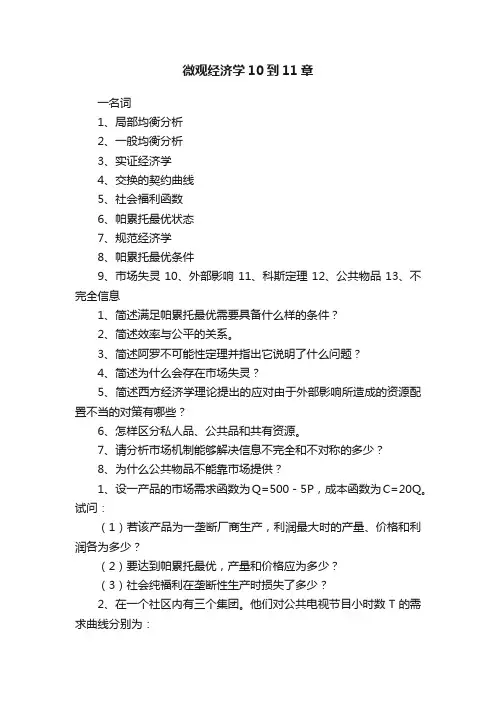
微观经济学10到11章一名词1、局部均衡分析2、一般均衡分析3、实证经济学4、交换的契约曲线5、社会福利函数6、帕累托最优状态7、规范经济学8、帕累托最优条件9、市场失灵10、外部影响11、科斯定理12、公共物品13、不完全信息1、简述满足帕累托最优需要具备什么样的条件?2、简述效率与公平的关系。
3、简述阿罗不可能性定理并指出它说明了什么问题?4、简述为什么会存在市场失灵?5、简述西方经济学理论提出的应对由于外部影响所造成的资源配置不当的对策有哪些?6、怎样区分私人品、公共品和共有资源。
7、请分析市场机制能够解决信息不完全和不对称的多少?8、为什么公共物品不能靠市场提供?1、设一产品的市场需求函数为Q=500-5P,成本函数为C=20Q。
试问:(1)若该产品为一垄断厂商生产,利润最大时的产量、价格和利润各为多少?(2)要达到帕累托最优,产量和价格应为多少?(3)社会纯福利在垄断性生产时损失了多少?2、在一个社区内有三个集团。
他们对公共电视节目小时数T的需求曲线分别为:W1=100-TW2=150-2TW3=200-T假定公共电视是一种纯粹的公共物品,它能以每小时100美元的不变边际成本生产出来。
(1)公共电视有效率的小时数是多少?(2)如果电视为私人物品,一个竞争性的私人市场会提供多少电视小时数?3、设一个公共牧场的成本是3000C,其中,x是牧场上养牛的头数。
牛的价格为=x52+P=1000元。
(1)求牧场净收益最大时的养牛数。
(2)若该牧场有5户牧民,牧场成本由他们平均分担。
这时牧场上将会有多少养牛数?从中会引起什么问题?4、假设有10个人住在一条街上,每个人愿意为增加一盏路灯支付4美元,而不管已提供的路灯数量。
若提供χ盏路灯的成本函数为()2χχ=C,试求最优路灯安装只数。
5、以农场主的作物缺水。
他须决定是否进行灌溉。
如他进行灌溉,或者天下有的话,作物带来的利润是1000元,但若是缺水,利润只有500元。
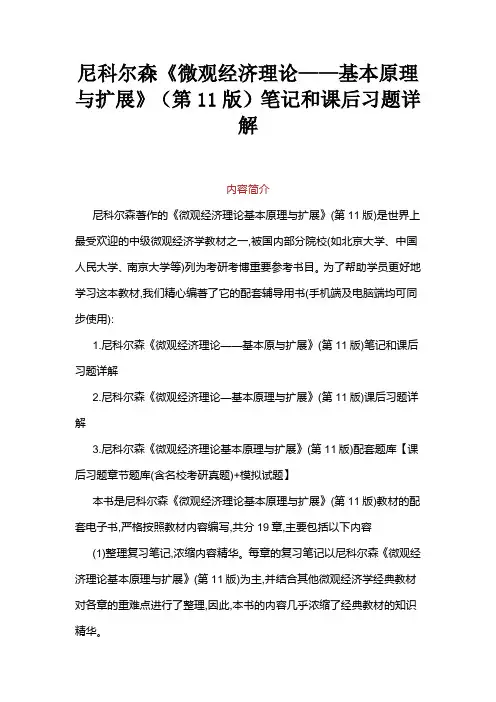
尼科尔森《微观经济理论——基本原理与扩展》(第11版)笔记和课后习题详解内容简介尼科尔森著作的《微观经济理论基本原理与扩展》(第11版)是世界上最受欢迎的中级微观经济学教材之一,被国内部分院校(如北京大学、中国人民大学、南京大学等)列为考研考博重要参考书目。
为了帮助学员更好地学习这本教材,我们精心编著了它的配套辅导用书(手机端及电脑端均可同步使用):1.尼科尔森《微观经济理论——基本原与扩展》(第11版)笔记和课后习题详解2.尼科尔森《微观经济理论—基本原理与扩展》(第11版)课后习题详解3.尼科尔森《微观经济理论基本原理与扩展》(第11版)配套题库【课后习题章节题库(含名校考研真题)+模拟试题】本书是尼科尔森《微观经济理论基本原理与扩展》(第11版)教材的配套电子书,严格按照教材内容编写,共分19章,主要包括以下内容(1)整理复习笔记,浓缩内容精华。
每章的复习笔记以尼科尔森《微观经济理论基本原理与扩展》(第11版)为主,并结合其他微观经济学经典教材对各章的重难点进行了整理,因此,本书的内容几乎浓缩了经典教材的知识精华。
(2)解析课后习题,提供详尽答案。
本书参考大量相关辅导资料对尼科尔森著作的《微观经济理论基本原理与扩展》(11版)的课后习题进行了详细的分析和解答,并对相关重要知识点进行了延伸和归纳。
目录第一篇引言第1章经济模型1.1 复习笔记1.2 课后习题详解第2章微观经济学中的数学工具2.1 复习笔记2.2 课后习题详解第二篇选择与需求第3章偏好与效用3.1 复习笔记3.2 课后习题详解第4章效用最大化与选择4.1 复习笔记4.2 课后习题详解第5章收入效应与替代效应5.1 复习笔记5.2 课后习题详解第6章商品间的需求关系6.1 复习笔记6.2. 课后习题详解第三篇不确定性与策略第7章不确定性7.1 复习笔记7.2 课后习题详解第8章博弈论8.1 复习笔记8.2 课后习题详解第四篇生产与供给第9章生产函数9.1 复习笔记9.2 课后习题详解第10章成本函数10.1 复习笔记10.2 课后习题详解第11章利润最大化11.1 复习笔记11.2 课后习题详解第五篇竞争性市场第12章竞争性价格决定的局部均衡模型12.1 复习笔记12.2 课后习题详解第13章一般均衡和福利13.1 复习笔记13.2 课后习题详解第六篇市场势力第14章垄断14.1 复习笔记14.2 课后习题详解第15章不完全竞争15.1 复习笔记15.2 课后习题详解第七篇要素市场定价第16章劳动力市场16.1 复习笔记16.2 课后习题详解第17章资本和时间17.1 复习笔记17.2 课后习题详解第八篇市场失灵第18章不对称信息18.1 复习笔记18.2 课后习题详解第19章外部性与公共品19.1 复习笔记19.2 课后习题详解第二章微观经济学中的数学工具1.已知U(x,y)=4x2+3y2。
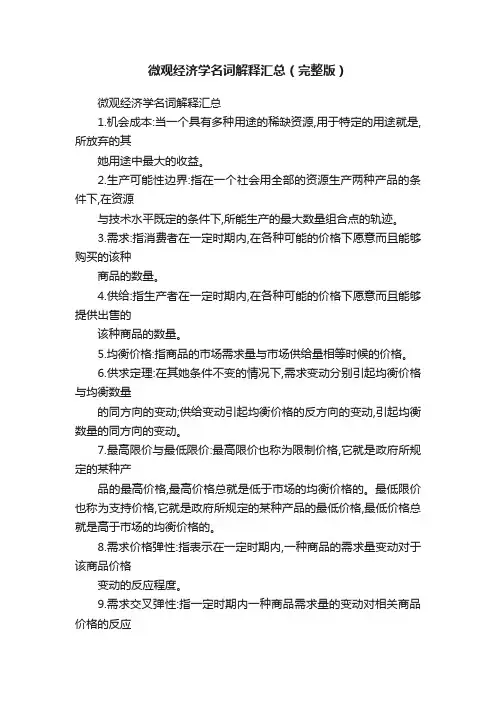
微观经济学名词解释汇总(完整版)微观经济学名词解释汇总1.机会成本:当一个具有多种用途的稀缺资源,用于特定的用途就是,所放弃的其她用途中最大的收益。
2.生产可能性边界:指在一个社会用全部的资源生产两种产品的条件下,在资源与技术水平既定的条件下,所能生产的最大数量组合点的轨迹。
3.需求:指消费者在一定时期内,在各种可能的价格下愿意而且能够购买的该种商品的数量。
4.供给:指生产者在一定时期内,在各种可能的价格下愿意而且能够提供出售的该种商品的数量。
5.均衡价格:指商品的市场需求量与市场供给量相等时候的价格。
6.供求定理:在其她条件不变的情况下,需求变动分别引起均衡价格与均衡数量的同方向的变动;供给变动引起均衡价格的反方向的变动,引起均衡数量的同方向的变动。
7.最高限价与最低限价:最高限价也称为限制价格,它就是政府所规定的某种产品的最高价格,最高价格总就是低于市场的均衡价格的。
最低限价也称为支持价格,它就是政府所规定的某种产品的最低价格,最低价格总就是高于市场的均衡价格的。
8.需求价格弹性:指表示在一定时期内,一种商品的需求量变动对于该商品价格变动的反应程度。
9.需求交叉弹性:指一定时期内一种商品需求量的变动对相关商品价格的反应程度。
10.需求收入弹性:指一定时期内消费者对某种商品需求量的变动对其收入水平变动的反应程度。
11.边际效用:指消费者在一定时间内增加一单位商品的消费所得到的效用量的增量。
12.消费者剩余:指消费者在购买一定数量的某种商品时愿意支付的总价格与实际支付总价格之差。
13.无差异曲线:指用来表示消费者偏好相同的两种商品不同数量的各种组合点所构成的曲线。
14.预算线:指在消费者收入与商品价格既定的条件下,消费者的全部收入所能购买到的两种商品的不同数量的各种组合。
15.边际替代率:指在维持效用水平不变的前提下,消费者增加一单位的某种商品的消费时所需要放弃的另一种商品的消费量。
16.价格——消费曲线:指在消费者的偏好、收入以及其她商品价格不变的条件下,与某一种商品的不同价格水平相联系的消费者效用最大化的均衡点的轨迹。

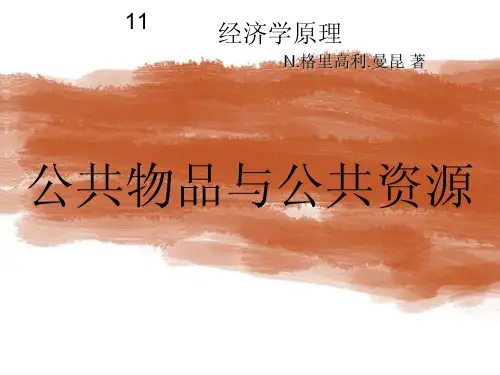
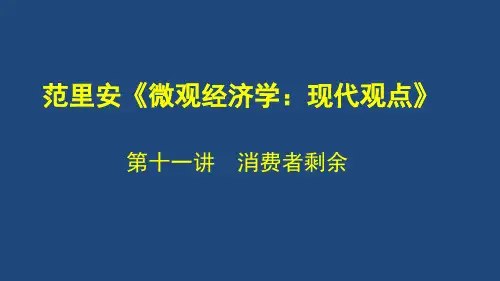
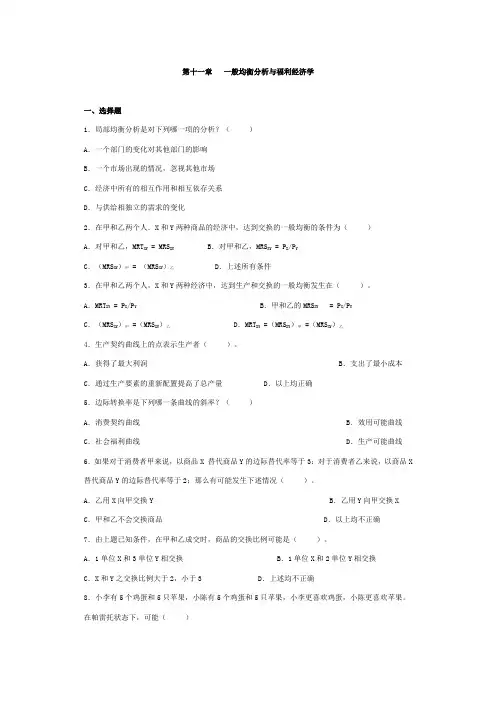
第十一章一般均衡分析与福利经济学一、选择题1.局部均衡分析是对下列哪一项的分析?()A.一个部门的变化对其他部门的影响B.一个市场出现的情况,忽视其他市场C.经济中所有的相互作用和相互依存关系D.与供给相独立的需求的变化2.在甲和乙两个人.X和Y两种商品的经济中,达到交换的一般均衡的条件为()A.对甲和乙,MRT XY = MRS XY B.对甲和乙,MRS XY = P X/P YC.(MRS XY)甲 = (MRS XY)乙 D.上述所有条件3.在甲和乙两个人,X和Y两种经济中,达到生产和交换的一般均衡发生在()。
A.MRT XY = P X/P Y B.甲和乙的MRS XY = P X/P YC.(MRS XY)甲 =(MRS XY)乙 D.MRT XY =(MRS XY)甲 =(MRS XY)乙4.生产契约曲线上的点表示生产者()。
A.获得了最大利润 B.支出了最小成本C.通过生产要素的重新配置提高了总产量 D.以上均正确5.边际转换率是下列哪一条曲线的斜率?()A.消费契约曲线 B.效用可能曲线C.社会福利曲线 D.生产可能曲线6.如果对于消费者甲来说,以商品X 替代商品Y的边际替代率等于3;对于消费者乙来说,以商品X 替代商品Y的边际替代率等于2;那么有可能发生下述情况()。
A.乙用X向甲交换Y B.乙用Y向甲交换XC.甲和乙不会交换商品 D.以上均不正确7.由上题已知条件,在甲和乙成交时,商品的交换比例可能是()。
A.1单位X和3单位Y相交换 B.1单位X和2单位Y相交换C.X和Y之交换比例大于2,小于3 D.上述均不正确8.小李有5个鸡蛋和5只苹果,小陈有5个鸡蛋和5只苹果,小李更喜欢鸡蛋,小陈更喜欢苹果。
在帕雷托状态下,可能()A.小李消费更多的鸡蛋 B.小陈消费更多的苹果C.两人的苹果和鸡蛋的边际替代率相等 D.上面说得都对9.社会福利函数是()A.个人福利函数的综合B.是社会偏好的表达方式之一C.是整个社会对事物进行排序的原则D.以上都对10.福利经济学是()A.实证经济学B.规范经济学C.宏观经济学D.科学经济学二、判断题1.为了达到帕累托最优,必须使任何两个厂商使用某两种投入要素的边际技术替代率相等,即使这两个厂商生产的产品很不相同。

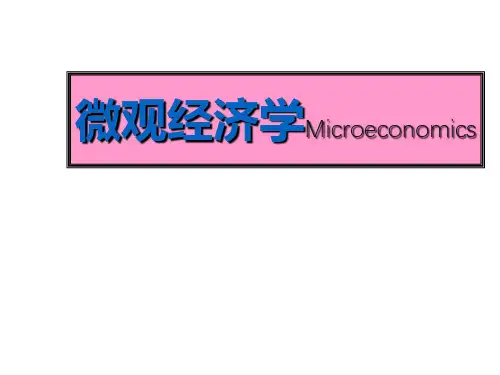

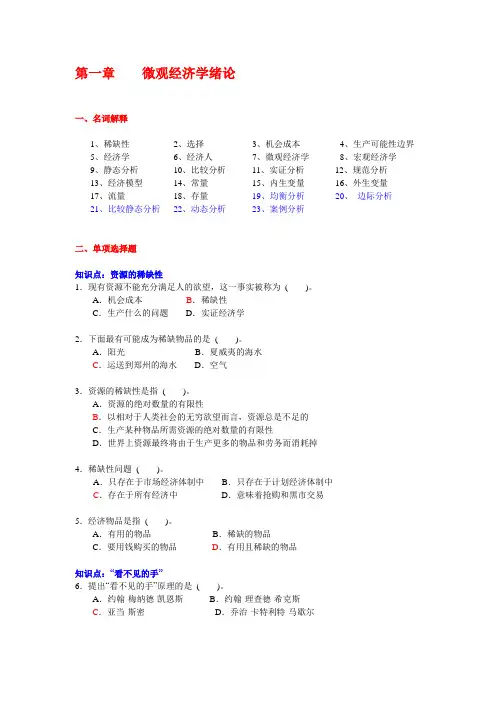
第一章微观经济学绪论一、名词解释1、稀缺性2、选择3、机会成本4、生产可能性边界5、经济学6、经济人7、微观经济学8、宏观经济学9、静态分析10、比较分析11、实证分析12、规范分析13、经济模型14、常量15、内生变量16、外生变量17、流量18、存量19、均衡分析20、边际分析21、比较静态分析22、动态分析23、案例分析二、单项选择题知识点:资源的稀缺性1.现有资源不能充分满足人的欲望,这一事实被称为( )。
A.机会成本B.稀缺性C.生产什么的问题D.实证经济学2.下面最有可能成为稀缺物品的是( )。
A.阳光B.夏威夷的海水C.运送到郑州的海水D.空气3.资源的稀缺性是指( )。
A.资源的绝对数量的有限性B.以相对于人类社会的无穷欲望而言,资源总是不足的C.生产某种物品所需资源的绝对数量的有限性D.世界上资源最终将由于生产更多的物品和劳务而消耗掉4.稀缺性问题( )。
A.只存在于市场经济体制中B.只存在于计划经济体制中C.存在于所有经济中D.意味着抢购和黑市交易5.经济物品是指( )。
A.有用的物品B.稀缺的物品C.要用钱购买的物品D.有用且稀缺的物品知识点:“看不见的手”6.提出“看不见的手”原理的是( )。
A.约翰·梅纳德·凯恩斯B.约翰·理查德·希克斯C.亚当·斯密D.乔治·卡特利特·马歇尔知识点:经济学的定义,三大基本经济问题7.经济学被定义为( )。
A.研究政府如何对市场机制进行干预的科学B.消费者如何获得收入并进行消费的学说C.研究如何合理配置稀缺资源于诸多竞争性用途的科学D.生产者怎样取得利润8.经济学研究的基本问题包括( )。
A.生产什么,生产多少B.怎样生产C.为谁生产D.以上所有的问题知识点:实证经济学与规范经济学,微观经济学与宏观经济学9.下列属于实证分析表述的是( )。
A.合理配置生产要素对厂商有利B.合理配置生产要素对厂商不利C.只有合理配置生产要素才能使利润最大化D.合理配置生产要素比市场营销更重要10.下列命题中不是实证经济学命题的是( )。
微观经济学名词解释重点名词解释:1.机会成本:是指当经济资源有多种用途时,把资源投入到某一种特定用途以后,在放弃其他的用途中,可能给选择者带来最大的利益。
=经济成本=隐性成本+显性成本2.需求:一种商品的需求是指消费者在一定时期内在该商品各种可能的价格水平下,愿意支付而且能够购买到的商品的数量。
3.供给:一种商品的供给是指生产者在一定时期内在该商品各种可能的价格下愿意而且能够提供的该商品的数量。
4.均衡价格:是指该种商品的市场需求量和市场供应量相等时的价格。
在均衡价格水平下的相等的供求数量被称为均衡数量。
5.需求的价格弹性:商品需求量随价格变化的反映程度即需求的价格弹性,通常被简称为需求弹性,它表示在一定时期内一种商品的需求量相对变动对于该商品的价格相对变动的反应程度。
6.需求的交叉价格弹性:也称为需求交叉弹性,它表示在一定时期内一种商品的需求量的相对变动对于它的相关商品的价格相对变动的反应程度。
它是该商品的需求量的变动率和它的相关商品价格的变动率的比值。
7.供给弹性:商品供给量随价格变化的反映程度即供给的价格弹性,通常被简称为供给弹性。
它表示在一定时期内一种商品的供给量相对变动对于该商品的价格相对变动的反应程度,即商品供给量变动率与价格变动率之比。
8.效用:商品满足人们欲望的能力。
或者说,效用是指消费者在消费商品时所感受到的满足程度9.边际效用(MU):消费者在一定时间内增加一单位商品的消费所增加的满足,也就是增加一个单位商品的消费所带来的总效用的增量。
10.边际效用递减规律:在一定时间内,在其它条件不变的情况下,随着消费者对某种商品消费量的连续增加,总效用是增加的,但是消费者从该商品连续增加的每一单位中所得到的效用增量,即边际效用,是递减的。
11.消费者均衡:在偏好不变,商品价格和消费者收入既定的情况下,消费者消费各种商品的数量组合实现最大的效用并保持不变的状态。
12.消费者剩余:是指消费者消费一定数量的某种商品时所愿意支付的最高总价格和实际支付的总价格之间的差额。
第十一章公共物品和共有资源复习题1.解释一种物品有“排他性”的含义。
解释一种物品有“消费中的竞争性”的含义。
一块比萨饼是否有排他性?是否有消费中的竞争性?答:一种物品具有“排他性”是指一种物品具有可以阻止一个人使用该物品的特性。
一种物品有“消费中的竞争性”是指一个人使用一种物品将减少其他人使用该物品的特性。
比萨饼有排他性,只要不卖给某人比萨饼就可以阻止他使用。
比萨饼也有竞争性,一个人多吃一块比萨饼,会使其他人少享受一块。
2.给公共物品下定义并举出一个例子。
私人市场本身能提供这种物品吗?解释原因。
答:公共物品是既无排他性又无竞争性的物品,比如小镇上的烟火表演。
私人市场本身不能提供这种物品。
公共物品没有排他性,因此,无法对公共物品的使用者收费,在私人提供这种物品时就存在搭便车的激励,从而使私人提供者无利可图。
3.什么是公共物品的成本一收益分析?为什么它很重要?为什么进行这种分析很困难? 答:公共物品的成本一收益分析是提供一种公共物品的社会成本和社会收益比较的研究。
只有比较提供一种公共物品的成本与收益,政府才能决定是否应该提供一种公共物品以及提供多少。
公共物品的成本一收益分析是一项艰苦的工作。
因为所有的人都可以免费使用一种公共物品,没有判断这种公共物品价值的价格。
简单地问人们,他们对一种公共物品的评价是多少是不可靠的。
那些受益于该公共物品的人有夸大他们的利益的激励。
那些受害于该公共物品的人有夸大他们成本的激励。
4.给公共资源下定义并举出一个例子。
没有政府干预,人们对这种物品的使用会太多还是太少?为什么?答:共有资源是有竞争性但无排他性的物品。
没有政府干预,人们使用这种物品会太多。
因为不能向使用共有资源的人收费,而且,一个人对共有资源的使用会减少其他人的使用,所以,共有资源往往被过度使用。
问题与应用1.考虑你们当地政府提供的物品与劳务。
A.用图11-1 中的分类解释下列每种物品属于哪个范畴:⊙警察保护⊙铲雪⊙教育⊙乡间道路⊙城市街道答:⊙警察保护属于自然垄断,因为它有排他性却无竞争性。
第四章1.(1)利用短期生产的总产量(TP)、平均产量(AP)和边际产量(MP)之间的关系,可以完成对该表的填空,其结果如下表:(2)所谓边际报酬递减是指短期生产中一种可变要素的边际产量在达到最高点以后开始逐步下降的这样一种普遍的生产现象。
本题的生产函数表现出边际报酬递减的现象,具体地说,由表可见,当可变要素的投入量由第4单位增加到第5单位时,该要素的边际产量由原来的24下降为12。
2.(1).过TPL曲线任何一点的切线的斜率就是相应的MPL的值。
(2)连接TPL曲线上热和一点和坐标原点的线段的斜率,就是相应的APL的值。
(3)当MPL>APL时,APL曲线是上升的。
当MPL<APL时,APL曲线是下降的。
当MPL=APL时,APL曲线达到极大值。
3.解答:(1)由生产数Q=2KL-0.5L2-0.5K2,且K=10,可得短期生产函数为:Q=20L-0.5L2-0.5*102=20L-0.5L2-50于是,根据总产量、平均产量和边际产量的定义,有以下函数:劳动的总产量函数TP L=20L-0.5L2-50劳动的平均产量函数AP L=20-0.5L-50/L劳动的边际产量函数MP L=20-L(2)关于总产量的最大值:20-L=0解得L=20所以,劳动投入量为20时,总产量达到极大值。
关于平均产量的最大值:-0.5+50L-2=0L=10(负值舍去)所以,劳动投入量为10时,平均产量达到极大值。
关于边际产量的最大值:由劳动的边际产量函数MP L=20-L可知,边际产量曲线是一条斜率为负的直线。
考虑到劳动投入量总是非负的,所以,L=0时,劳动的边际产量达到极大值。
(3)当劳动的平均产量达到最大值时,一定有APL=MPL。
由(2)可知,当劳动为10时,劳动的平均产量APL达最大值,及相应的最大值为:APL的最大值=10MPL=20-10=10很显然APL=MPL=104.解答:(1)生产函数表示该函数是一个固定投入比例的生产函数,所以,厂商进行生产时,Q=2L=3K.相应的有L=18,K=12(2)由Q=2L=3K,且Q=480,可得:L=240,K=160又因为PL=2,PK=5,所以C=2*240+5*160=1280即最小成本。
I. Single choice questions1. Which of the following is NOT a condition of a perfect competition:a. Products produced by rival firms are perfect substitutes.b. Any individual firm cannot affect market supply.c. Unrestricted entry and exit.d. Industry sales are small.e. Each firm has complete knowledge about production and prices.2. In a perfectly competitive market.a. A firm must lower price to attract more customers.b. The additional revenue from selling one more unit of output is less than price.c. Demand facing the industry is perfectly elastic.d. All of the above.e. None of the above.3. For a price-taking firm, marginal revenuea. Is the addition to total revenue from producing one more unit of output.b. Decreases as the firm produces more output.c. Is equal to price at any level of output.d. Both a and b.e. Both a and c.The next three questions refer to the following:The graph on the left shows the short-run marginal cost curve for a typical firm selling in a perfectly competitive industry. The graph on the right shows current industry demand and supply.4. If the firm's demand and marginal revenue curves were drawn in the left-hand graph, what would be the elasticity of demand?a. Zero.b. -6.c. -0.6.d. Infinitely elastic.e. Unitary.5. What is the marginal revenue for the FIRM from selling the 250th unit of output?a. $10.b. $8.c. $6.d. $4.e. Zero.6. What output should the firm produce?a. 200.b. 250.c. 150.d. 300.7 When total fixed costs increase,a. The profit-maximizing level of output falls.b. The firm may be forced to shut down if total fixed costs get too high.c. Economic profit decreases.d. Both a and b.e. Both b and c.8. A competitive firm will maximize profit by producing the level of output at which:a. The last unit of output produced adds the same amount to total revenue as to total cost.b. The additional revenue from the last unit of output produced exceeds the additional cost of the last unit by the largest amount.c. The firm's total revenue exceeds total cost by the largest amount.d. Both a and b.e. Both a and c.9. Firm A and firm B both have total revenues of $200,000 and total costs of $250,000; firm A has total fixed costs of $40,000, while firm B has total fixed costs of $70,000. Which of the following statements are true in the short run?a. Firm A should operate.b. Firm B should operate.c. Firm A should shut down.d. Firm B should shut down.e. Both b and c.10. When a perfect competitive industry is in long-run equilibrium,a. Firms have no incentive to enter or exit the industry.b. Market price is equal to minimum long-run average cost.c. Each firm earns a normal return.d. Both a and c.e. All of the above.11. An industry is in long-run competitive equilibrium. The price of a substitute good increases.a. The product price will rise.b. New firms will enter the market.c. Firms will begin earning economic profit.d. a and b.e. All of the above.12. A typical firm in a perfectly competitive market made positive economic profits last period. This period,a. Market supply will increase.b. Market price will rise.c. The firm will produce more.d. The firm's profits will increase.13. Which of the following CANNOT be true at any output along a perfectly competitive firm'sshort-run supply curve?a. Average total cost is greater than marginal cost.b. Marginal cost is greater than average total cost.c. Average variable cost is greater than marginal cost.d. Marginal cost is greater than average variable cost.14. In a perfectly competitive market,a. A firm can attract more customers by lowering its price.b. A firm can sell as much as it wants at the existing market price.c. The additional revenue from selling one more unit of output is less than the market price.d. Both a and c.e. Both b and c.15. In a competitive industry the market-determined price is $12. A firm is currently producing 50 units of output; average total cost is $10, marginal cost is $15, and average variable cost is $7. In order to maximize profit, the firm should:a. Produce more because the firm is earning a profit of $100.b. Keep output the same because the firm is earning a profit of $100.c. Produce more because the next unit of output increases profit by $2.d. Produce less because the last unit of output decreased profit by $3.16. Consider the short-run supply curve for a perfectly competitive industry. In general, which of the following statements are true?a. The short-run industry supply is obtained by horizontally summing the supply curves of all the individual firms in the industry.b. The industry supply curve tends to be flatter (more elastic) than the horizontal sum of all the industrial firms' supply curves.c. Short-run supply for a perfectly competitive industry is flat for constant cost industries.d. Both a and b.e. None of the above are true in general.The next four questions refer to the following figure:The graph on the left shows long-run average and marginal cost for a typical firm in a perfectly competitive industry. The graph on the right shows demand and long-run supply for an increasing-cost industry.17. What output will the firm produce?a. 250.b. 300.c. 350.d. 400.18. How much profit will the firm earn?a. Zero.b. $2,600.c. $3,100.d. $3,750.e. $6,000.19. If this were a constant-cost industry, what would be the price when the industry gets to long-run competitive equilibrium?a. Between $35 and $20.b. $35.c. $20.d. Below $20.e. Above $35.20. If this were an increasing cost industry, what would be the price when the industry gets to long-run competitive equilibrium?a. Between $35 and $15.b. $35.c. $15.d. Below $15.e. Above $35.21. A firm with market powera. Can increase price without losing all sales.b. Faces a downward-sloping demand curve.c. Is the only seller in a market.d. Both a and b.e. All of the above.22. One method of measuring the extent of a firm's market power isa. The Lerner index.b. Price elasticity of demand for the firm's product.c. Income elasticity of demand for the firm's product.d. Both a and b.e. All of the above.23. A monopolistic competitor is similar to a monopolist in thata. Both have market power.b. Both earn positive economic profit in the long run.c. Both produce the output at which long-run average cost is at a minimum.d. a and b.e. All of the above.24. A monopoly is producing a level of output at which price is $80, marginal revenue is $40, average total cost is $100, marginal cost is $40, and average fixed cost is $10. In order to maximize profit, the firm shoulda. Produce more.b. Keep output the same.c. Produce less.d. Shut down.The next 3 questions refer to the following figure:The above graph shows the demand and cost conditions facing a price-setting firm.25. When output is 50 units, what will happen to total revenue if the firm sells another unit of output?a. Total revenue will increase $13.50.b. Total revenue will increase $11.00.c. Total revenue will increase $9.00.d. Total revenue will increase $6.00.e. None of the above.26. The firm will produce _____ units of output and charge a price of _____.a. 40, $8.b. 50, $9.c. 60, $10.d. 50, $6.e. None of the above.27. What is the maximum amount of profit the firm can earn?a. -$180.b. -$80.c. $60.d. $120.e. None of the above.28. A monopolist which suffers losses in the short run willa. Continue to operate as long as total revenue covers fixed cost.b. Raise price in order to eliminate losses.c. Exit in the long run if there is no plant size that will result in economic profit that is greater than or equal to zero.d. Both a and b.e. Both a and c.29. Suppose that a profit-maximizing monopolist has a plant of the optimal size and is producinga level of output at which price is $30, average total cost is $55, and average fixed cost is $40. The firm shoulda. Operate in the short run.b. Shut down in the short run.c. Exit the market in the long run.d. Continue to operate in the long run.e. Both a and c.30. If a monopolistically competitive market is in long-run equilibrium, each firma. Charges a price which is higher than long-run marginal cost.b. Earns economic profits.c. Produces that level of output at which long-run average cost is minimum.d. All of the above.e. None of the above.31. A monopolistic competitor is producing a level of output at which price is $200, marginal revenue is $100, average total cost is $210, marginal cost is $100, and average variable cost is $180. In order to maximize profit, the firm shoulda. Increase output.b. Keep output the same.c. Decrease output.d. Shut down.The next 6 questions refer to the following:A firm with market power faces the following estimated demand and average variable cost functions:where is quantity demanded, P is price, M is income, and is the price of a related good. The firm expects income to be $40,000 and to be $2. Total fixed cost is $100,000.32. What is the estimated demand function for the firm?a. = 71,000 - 500P.b. = 39,000 - 200P.c. = 39,000 - 500P.d. = 40,000 - 200P.33. What is the estimated marginal revenue function for the firm?a. MR = 48 - 0.002Q.b. MR = 78 - 0.002Q.c. MR = 78 - 0.004Q.d. MR = 48 - 0.004Q.34. What is the profit-maximizing choice of output?a. 8,000 units.b. 10,000 units.c. 12,000 units.d. 16,000 units.e. 0 units, the firm shuts down.35. What price should the firm charge in order to maximize profit?a. $42.50.b. $48.c. $50.d. $62.e. $70.36. The firm should ______________ because _______________.a. shut down, P = $62 < TVC = $229.50.b. operate, P = $62 > A VC = $17.50.c. operate, P = $62 > A VC = $22.d. operate, P = $60.50 > A VC = $25.50.37. What is the firm's profit?a. $147,000.b. $120,000.c. $220,000.d. $335,000.38. In order to maximize profit, a firm that produces its output in two plants will produce the level of total output at which the last unit of output produced adds the same amount to total revenue as to thea. First plant's total cost.b. Second plant's total cost.c. Firm's total cost.d. Both a and b.39. A firm is producing 10,000 units of output in two plants, A and B, and each plant is producing 5,000 units of output. The marginal cost in plant A is $10 and the marginal cost in B is $6. To reduce the cost of producing 10,000 units the firm shoulda. Produce more in A and less in B.b. Produce less in A and more in B.c. Produce it all in B because B is the lower cost plant.d. Do nothing since the output in each plant is equal.40. In order to maximize profit, the firm shoulda. Keep the allocation between plants unchanged.b. Produce all its output in the Taiwan plant.c. Produce all its output in the California plant.d. Switch some output from the California to the Taiwan plant.e. Switch some output from the Taiwan to the California plant.II. Fill in blanks1. A perfectly competitive firm's demand is ____________ elastic and equal to ____________ which is equal to ____________.2. A perfectly competitive firm in the short run willa. Produce the output at which _____________________ equals __________________ and make an economic profit if price exceeds __________________.b. Produce the output at which __________________ equals __________________ and make a loss if price is between __________________ and __________________.c. Shut down if price is below ________________________ and make a loss of __________________.3 A competitive firm estimates its average variable cost function to be .The firm's total fixed cost is $3,500.a. The marginal cost function associated with this average variable cost function isSMC =__________________________.b. A VC reaches its minimum at ______ units of output. Minimum AVC is _________.c. Suppose the price of the product is P = $125. The firm should produce _________ units of output. The firm earns a profit (loss) of __________________.d. Suppose the price of the product is P = $115. The firm should now produce _________ units of output. Its profit (loss) will be _________.e. Suppose the price of the product falls to P = $100. The firm should produce _________ units of output. Its profit (loss) will be ____________.4. Fill in the blanks:a. A monopoly can raise its price without ______________________, because it has ________________________.b. Two related ways to measure the extent of a firm's market power are ______________________________ and ___________________________________.c. Monopolistically competitive firms will have their economic profit competed away in the long run because of ____________________________________________________________. They will however earn ____________________ in the long run.d. A firm with market power will produce at a loss in the short run only if _____________________________. If this condition is met and the firm does produce at a loss, the firm will lose ____________ (more, less) than its total fixed costs. In the long run, this firm will leave the industry if _______________________________.5. The following figure shows the average revenue product (ARP) and marginal revenue product curves of monopoly for its only variable input, labor.a. If the wage is $30, the firm will hire _________ workers.b. If the wage is $10, the firm will hire __________ workers. Total revenue is ________ (hint: ARP = P(Q/L), total variable cost is ________. If total fixed cost is $550, the firm earns a profit of ________.c. If the wage is $60, the firm will hire _________ workers.6. A firm produces its output in two plants, A and B.a. To maximize its profit, the firm should produce the output at which ______ equals ______. It sets the price given by ______.b. It should allocate this output between the two plants so that ______ equals ______.c. If marginal cost in plant A is $20 and the marginal cost in plant B is $15, the firm should reduce output in ______ and increase output in ______. As it continues this reallocation ______ will increase and ______ will decrease.。